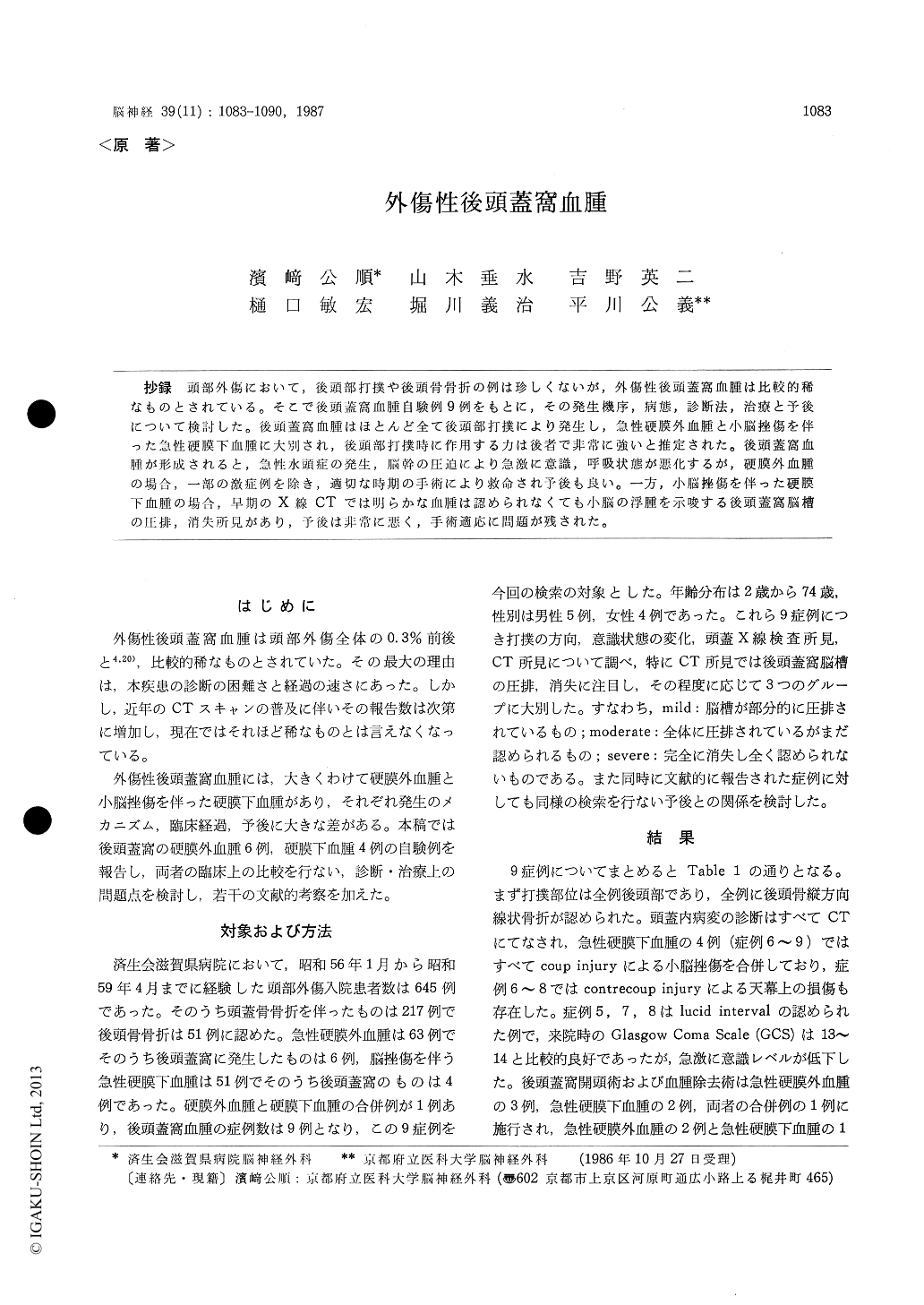Japanese
English
- 有料閲覧
- Abstract 文献概要
- 1ページ目 Look Inside
抄録 頭部外傷において,後頭部打撲や後頭骨骨折の例は珍しくないが,外傷性後頭蓋窩血腫は比較的稀なものとされている。そこで後頭蓋窩血腫自験例9例をもとに,その発生機序,病態,診断法,治療と予後について検討した。後頭蓋窩血腫はほとんど全て後頭部打撲により発生し,急性硬膜外血腫と小脳挫傷を伴った急性硬膜下血腫に大別され,後頭部打撲時に作用する力は後者で非常に強いと推定された。後頭蓋窩血腫が形成されると,急性水頭症の発生,脳幹の圧迫により急激に意識,呼吸状態が悪化するが,硬膜外血腫の場合,一部の激症例を除き,適切な時期の手術により救命され予後も良い。一方,小脳挫傷を伴った硬膜下血腫の場合,早期のX線CTでは明らかな血腫は認められなくても小脳の浮腫を示唆する後頭蓋窩脳槽の圧排,消失所見があり,予後は非常に悪く,手術適応に問題が残された。
The traumatic posterior fossa hematoma was re-garded as relatively rare thing, but recently, as the result of the prevalence of CT scanners, the number of reported cases is increasing.
We report nine cases of traumatic posterior fossa hematoma. We divided into two categories : one was the acute epidural hematoma, the other was the acute subdural hematoma with cerebellar con-tusion. Five were cases of the acute epidural hematoma, three were cases of the acute subdural hematoma with cerebellar contusion and a case had both an epidural and a subdural hematoma. All the cases had struck the occipital region and had the occipital bone fracture. The prognosis of the five cases of the acute epidural hematoma was excellent, but that of the four cases of the acute subdural hematoma with cerebellar contusion was poor and they all died inspite of the removal of the hematoma executed in three cases.
We estimated that the hitting forth was extreme-ly strong in cases of the subdural hematoma with cerebellar contusion, and that the momentary de-formity of the occipital bone might injure the cerebellum directly. Once a hematoma was pro-duced in the posterior fossa, it oppresses the brainstem and causes the acute hydrocephalus, so the state of consciousness and respiration deterio-rate suddenly. In cases of the acute epidural hematoma, appropriate surgical intervention could save the patients and resulted in good outcome. But in some cases of the fulminant type acute epidural hematoma of the posterior fossa caused by tearing the sinuses, though we have not experi-enced, patients die before the diagnosis and treat-ment. In cases of the acute subdural hematoma with cerebellar contusion, as there existed the bone artifact in X-ray CT of the posterior fossa, subtle high or low density area of the early stage cerebellar contusion could not be detected. Only the finding of the cerebellar swelling was noted in early CT. In such a case, the posterior fossacisterns and the fourth ventricle were completely disappeared. Once the cerebellar swelling occurred, the suboccipital craniectomy, removal of the sub-dural hematoma and the intracerebellar hematoma were not sufficient for the decompression. This disappearance of the posterior fossa cisterns was the indicator of the primary or seccondary brain-stem injury and the poor prognosis.
We reviewed reported cases of the posterior fossa injury and discussed about the mechanism of the production of the cerebellar contusion, the pathophysiology, the diagnosis and treatment.

Copyright © 1987, Igaku-Shoin Ltd. All rights reserved.


